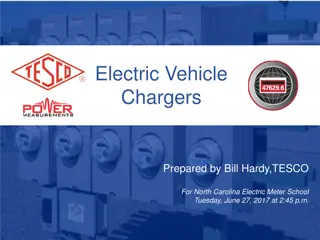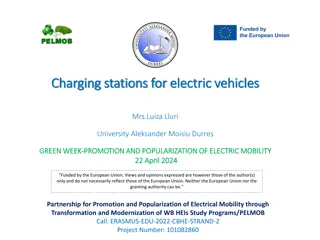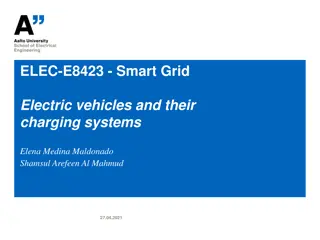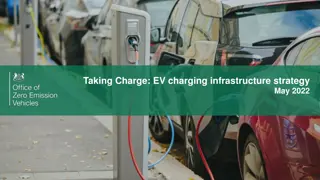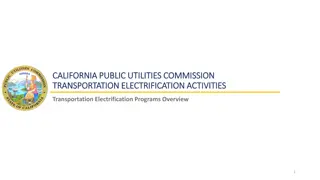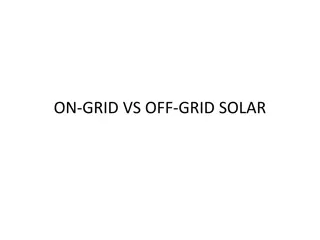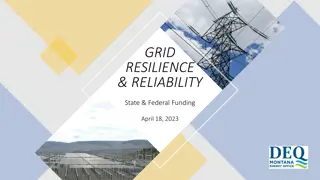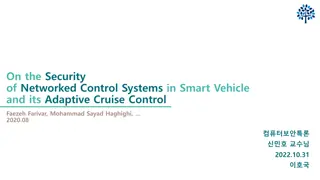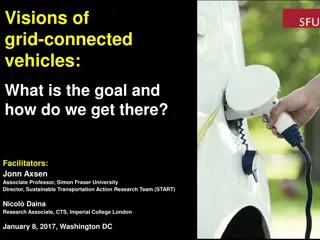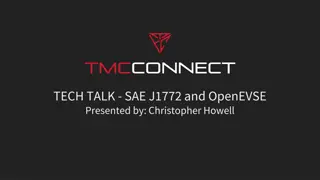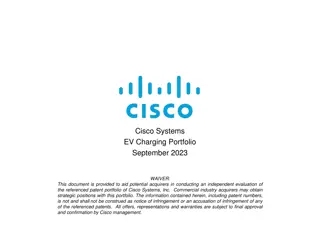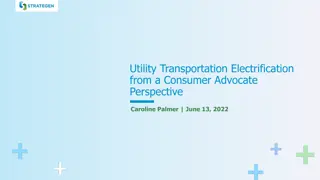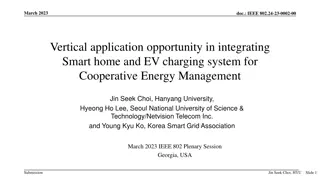Smart Grid Electric Vehicles Charging Systems in Finland
Finland aims to reduce traffic emissions by 50% by 2030, with plans for a significant increase in Electric Vehicles (EVs) and charging infrastructure. The country targets 250,000 EVs by 2030, supported by 1.5 million car heating poles that can double as EV chargers. Various charging modes, control units, and standardized plugs are discussed, emphasizing the growth of public charging stations. Additionally, Battery Management Systems play a crucial role in managing charging operations, ensuring efficient power transfer between the grid and vehicles.
Download Presentation

Please find below an Image/Link to download the presentation.
The content on the website is provided AS IS for your information and personal use only. It may not be sold, licensed, or shared on other websites without obtaining consent from the author.If you encounter any issues during the download, it is possible that the publisher has removed the file from their server.
You are allowed to download the files provided on this website for personal or commercial use, subject to the condition that they are used lawfully. All files are the property of their respective owners.
The content on the website is provided AS IS for your information and personal use only. It may not be sold, licensed, or shared on other websites without obtaining consent from the author.
E N D
Presentation Transcript
ELEC-E8423 - Smart Grid Electric vehicles and their charging systems Sami Herranen Markus Kopiloff 24.04.2018
Introduction Finland s target is to cut the traffic emissions by 50% by 2030 Today 7000 EVs in Finland Target is to have 250 000 EVs in 2030 Domestic charging stations 1 500 000 car heating poles which could be utilized for EV charging Dedicated charging station needed for long term usage Public charging stations Today 300 in Finland Target is to have 25 000 in 2030 Public charging station network is intended to grow on a market-based basis by energy companies and other commercial actors Construction is to be supported with subsidies Sources: [1] 24.04.2018 Page 2
Charging modes Modes Usage Power (max) Voltage Charger Mode 1 Light vehicles 2 (3,5) kW AC, 1-ph Uncontrolled, normal cable Mode 2 Slow charging 7 (11) kW AC, 1 or 3-ph Cable with control unit Mode 3 Basic charging 22 (43) kW AC, 3-ph Dedicated EV charger socket Mode 4 Quick charging 50 (350) kW DC Special power charger Charging control abilities: Modes 1 and 2 uses normal household sockets and plugs for grid connection no data pins Modes 3 and 4 uses EV dedicated multi-pin sockets for communication between car and grid 1 3 2 4 Control unit Sources: [2] 24.04.2018 Page 3
Charging systems Control unit Mode 1 to be used only for LEVs, not for EVs Mode 2 meant only for temporarily usage as mode 3 is preferred choice Public charging stations shall have smart charging abilities mode 3 or 4 Schuko plug Standardized plugs and sockets for public chargers in Europe: Basic and slow charging (AC) Type 2 Quick charging (DC) CSS Combo Other types also exists e.g. US, Japanese and Chinese Also wireless charging for EVs is under development Induction charging pads for stationary charging Induction charging roadways for charging-on-to-move Sources: [1], [2] 24.04.2018 Page 4
Charging of electric vehicle Battery management systems (BMS) controls the charging operation State of charge (SoC) and needed charging current Car is the master and charger is a slave! Operation shall be stopped if communication is lost AC-DC conversion is done with on-board charger Charging time depends from: Charging power Battery capacity and SoC Temperature Overall efficiency: Ca. 78 88 % for Grid-to-Vehicle (G2V) Ca. 64 72 % for Vehicle-to-Grid (V2G) Sources: [1], [3], [4] 24.04.2018 Page 5
Smart charging Requires communication between EV and the grid Connection to local or cloud based central system Enables remote load management (power control) Open Charge Point Protocol (OCPP) Open standard to communicate with any charge point to any central system To uniform systems regardless of the system vendor Open Smart Charging Protocol (OSCP) 24-hour forecast of the available capacity To prevent overloading the grid Sources: [5], [6] 24.04.2018 Page 6
Charging services EV charging operators Offers and operates charging stations and services Public and domestic stations can be operated Usage and payments e.g. with RFID tags Multiple plugged EVs form a virtual power plant to be utilized for demand response Charging for EVs demand response for the grid EV demand response is a two-way possibility: V2G EV is power bank when low production G2V EV is power sink for surplus production Sources: [7] 24.04.2018 Page 7
Conclusions Standardization and subsidies to ease up propagation Communication between EV and the grid is a key thing Two-way demand response with smart charging 24.04.2018 Page 8
Source material used [1] J. Vesa. 2017. S hk autojen lataus (Finnish). Presentation slides. http://www.tukes.fi/Tiedostot/pelastustoimen_laitteet/2017_Vesa_S%C3%A4hk%C3%B6autojen_lataus.pdf [2] SESKO ry. 2018. S hk ajoneuvojen lataussuositus (Finnish). http://www.sesko.fi/standardit/standardoinnin_aihealueita/sahkoautot_ja_latausjarjestelmat/lataussuositus [3] E. Apostolaki-Iosifidou, P. Codani, W. Cempton. 2017. Measurement of power loss during electric vehichle charging and discharging. https://doi.org/10.1016/j.energy.2017.03.015 [4] A. Genovese, F. Ortenzi, C. Villante. 2015. On the energy efficiency of quick DC vehicle battery charging. https://www.researchgate.net/publication/274316538 [5] Rexel Finland Oy. 2017. S hk autojen latausj rjestelm (Finnish). Presentation slides. http://www.nssoy.fi/uploads/NSS-sahkoteleturva-rexel.pdf [6] Open Charge Alliance websites. Visited 18.4.2018. http://www.openchargealliance.org/ [7] Liikennevirta Oy. Visited 18.4.2018. http://www.virta.global/ 24.04.2018 Page 9
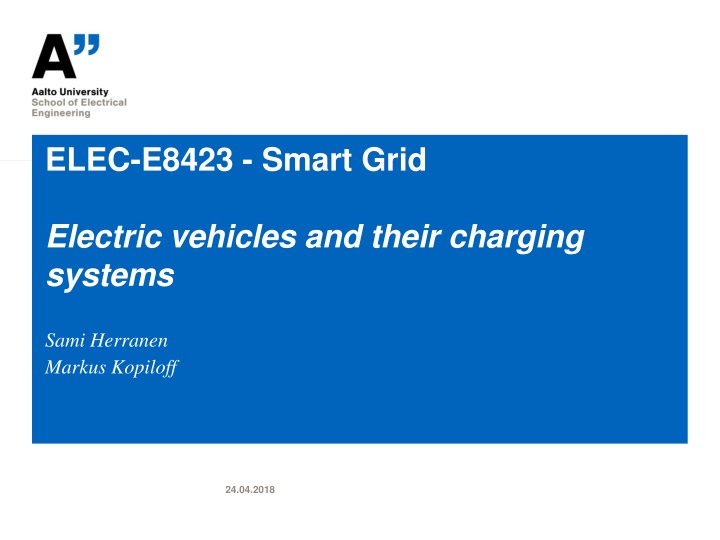

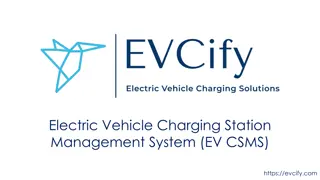


![Long-Range Wireless Charging Market Report & Analysis _ BIS Research [2024-2035]](/thumb/87166/long-range-wireless-charging-market-report-analysis-bis-research-2024-2035.jpg)
